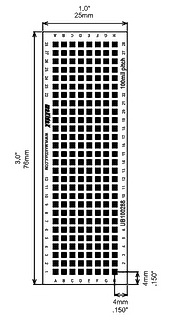DBAT90USB162 Atmel® AT90USB162 Development Board
One of today's most widely used MCUs offering native USB support is the Atmel® AT90USB162. It provides an easy way to add USB functionality to any new design along with hundreds of different projects that are available. The DBAT90USB162 is an enhanced Atmel® AT90USB162 development board which also accepts AT90USB82. Offering modular design, this board is a cost-effective yet feature rich, highly compatible, flexible and easily configurable development tool, designed to give a quick start to develop code and for hardware prototyping and testing. Its design provides configurability and flexibility not available with other products. The board provides all the basic circuitry needed to work with AT90USB162: USB connector and circuit, crystal and clock configuration circuitry, Reset and HWB buttons, status LED, user button and LED, power source/voltage configuration circuitry, configurable voltage regulator, isolation resistors to combine ISP lines with other functions. The board either accepts a MCU directly or uses additional header boards for MCU installation giving the developer the freedom of using one development board with several MCUs, eventually programmed with different code. An extension header is available allowing connection of various size universal boards such as the usually included UB100288 or breadboards holding the rest of the circuitry, and eventually using different hardware, or direct interfacing with other devices. Furthermore most board components are detachable or configurable via jumpers. The board offers flexible power: both 3.3 V and 5 V USB-powered or from external supply. The board also features a built-in voltage regulator, configurable to 3.3 V and 5 V with overcurrent and thermal protection. Board design makes it compatible with other similar development boards featuring same or similar MCUs and virtually all design/development software and libraries, including open source. MCU comes pre-programmed with a bootloader allowing code to be programmed inside the chip without any external programmer – simply by using FLIP software from Atmel. To enter the bootloader mode, the RST button should be pressed and hold, then the HWB button pressed and the RST button released. An ICSP programmer still can be used via dedicated ISP header, as well as debugger like JTAGICE via same header. JTAG header is also available making it easy to use debuggers like JTAGICE, but only via debugWIRE. |
|||||||||||||||||||||||||||||||||||||
|
FEATURES
COMPATIBILITY As all MCU I/O pins are accessible and all MCU powering and clocking options are available the SBAT90USB162a is compatible with virtually every project and development tool designed for AT90USB162 and particularly for AVR MCUs. |
SPECIFICATIONS
|
||||||||||||||||||||||||||||||||||||
DOWNLOADS

|

|

|

|
ITEM INCLUDES
| 1. | DBAT90USB162 development board with Atmel® AT90USB162AU MCU and 8 MHz crystal | 1 pc |
| 2. | DB100288 universal board | 1 pc |
| 3. | Jumper caps | 7 pcs |



